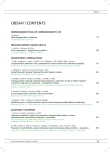Computer-Designed Implants for Calvarial Bone Defects
Authors:
P. Buchvald 1; L. Čapek 2
; P. Suchomel 1
Authors‘ workplace:
Ne urochirurgické oddělení Krajské nemocnice Liberec, a. s., 2Strojní fakulta Technické univerzity v Liberci
1
Published in:
Cesk Slov Neurol N 2009; 72/105(2): 169-172
Category:
Short Communication
Overview
The most frequent procedure used in the Czech Republic for the closure of acquired calvarial bone defects (cranioplasty) uses the modelling of an acrylic implant, which solidifies gradually, into the desired shape directly in the theatre on the basis of the surgeon’s estimate. However, even minor inaccuracy in an implant modelled this way may have far-reaching clinical and cosmetic consequences. Problems can be avoided by modelling implants using digital data obtained from spiral computer tomography. The data is processed by a special graphic program and converted from the virtual computer form to reality with the use of the 3D printing method. The mould which is thus created is used for casting a precise implant “tailored” to the specific patient. The article reports on a group of ten patients who underwent the surgery and provides a detailed description of the above technique.
Key words:
cranioplasty – decompressive craniotomy – reverse engineering
Sources
1. Maekawa M, Awaya S, Teramoto A. Cerebral blo od flow (CBF) before and after crani oplasty performed during the chronic stage after decompressive crani ectomy evalu ated by Xe - CT CBF scanning. No Shinkei Geka 1999; 27(8): 717 – 722.
2. Müller A, Krishnan K, Uhl E, Mast G. The applicati on of RP techniques in crani al reconstructi on and pre operative planning in ne urosurgery. J Crani ofac Surg 2003; 14(6): 889 – 914.
3. Popovic A, Engelhardt M, Wu T, Portheine F, Schmi eder K, Radermacher K. CRANIO - computer - assisted planning for navigated and robot - assisted surgery on the skull. Internati onal Congress Seri es 2003; 1256 : 1269 – 1275.
4. Sto odley MA, Abbott JR, Simpson DA. Titani um crani oplasty using 3 - D computer modelling of skull defects. J Clinic Ne urosci 1996; 3(2): 149 – 155.
5. Girod S, Teschner M, Schrell U, Kevekordes B, Girod B.Computer aided 3 - D simulati on and predicti on of crani ofaci al surgery: a new appro ach. J Crani omaxillofac Surg 2001; 29(3): 156 – 158.
6. Robb AR. Visu alizati on in bi omedical computing. Parallel Comput 1999; 25(13 – 14): 2067 – 2110.
7. Capek L, Buchvald P, Dzan L. Prototyping of crani o - maxillofaci al implants. 2nd IC - SCCE conference 2006; 1 : 154–158.
Labels
Paediatric neurology Neurosurgery NeurologyArticle was published in
Czech and Slovak Neurology and Neurosurgery

2009 Issue 2
- Memantine Eases Daily Life for Patients and Caregivers
- Metamizole at a Glance and in Practice – Effective Non-Opioid Analgesic for All Ages
- Hope Awakens with Early Diagnosis of Parkinson's Disease Based on Skin Odor
- Metamizole vs. Tramadol in Postoperative Analgesia
- Possibilities of Using Metamizole in the Treatment of Acute Primary Headaches
Most read in this issue
- Cervical Myelopathy – a Diagnostic Problem
- Neurodegenerative Dementias
- Malignant Peripheral Nerve She ath Tumor – Two Case Reports
- Radi ofrequency Therapy of Lumbar Facet Pain
